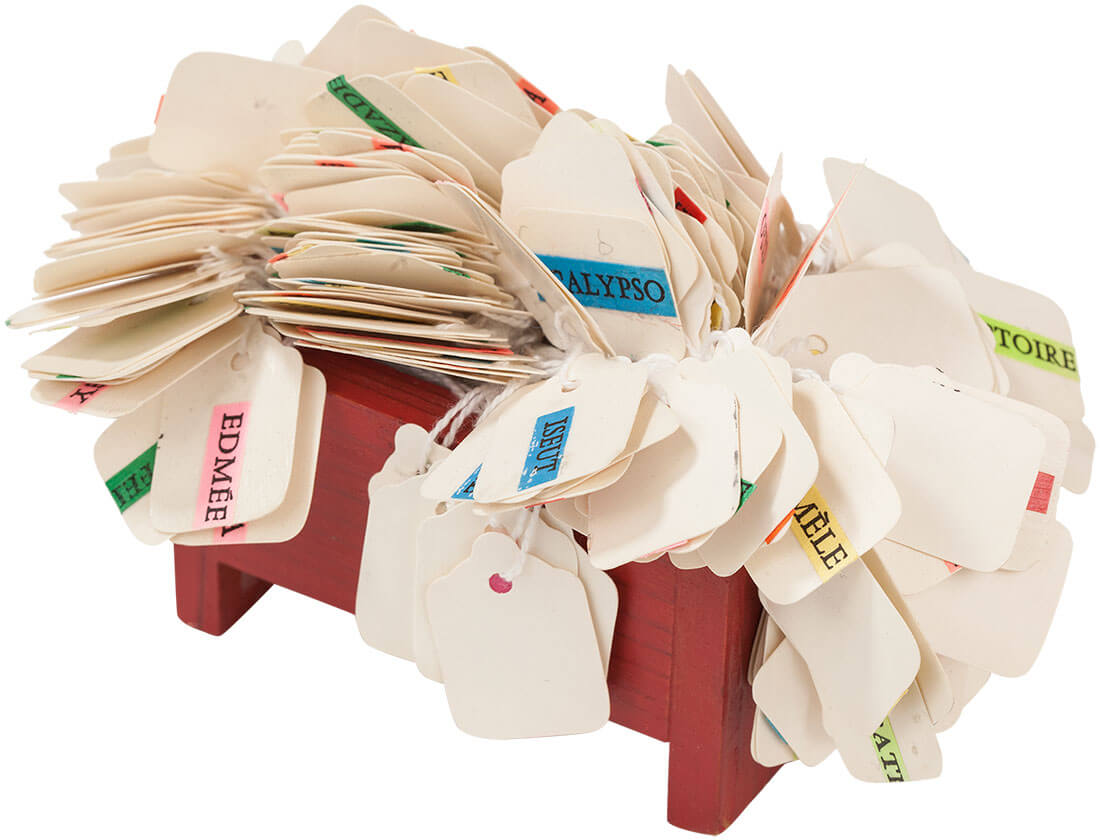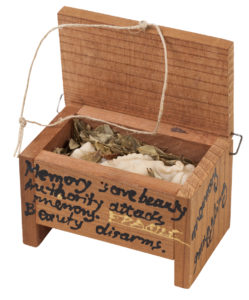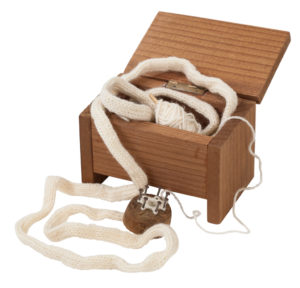Sania Papa Ph.D., Director of the Thessaloniki Center of Contemporary Art – GREECE – 1996

Twelve Greek women artists of different generations are participating in this unique exhibition of Women Beyond Borders, a symbolic journey enclosing and dispersing at the same time the transcultural memory of a polysemic past-present. The boxes reveal a multitude of transformations: ambiguous, tragic, enigmatic, subversive, astonishing, tender. They offer different levels of meaning and interpretation: physical, intellectual, emotional. The Greek participants follow the laws and principles of the esoteric harmony of their logos. They become the “hermeneutes” of their individual histories, which arise from their relevant motherland and tradition.
During the present period of political, social, and cultural disharmony and the domination of the mass media, a characteristic homogeneity establishes a norm for all forms of human communication, thus destroying the meaning of duration, interior time, and authenticity in works of art. This effete eclecticism creates a misleading spiritual euphoria, based on the repetition, the fake, the feigned and the substitute.
WBB reinforces the dire need for a truthful and authentic communication, which will reveal the importance and power of a spiritually rejuvenated plane of human relationship among the members of world-wide family of art.
The Greek artists participants are expatriates and scattered, living in a variety of different countries (Greece, USA, France, United Kingdom, Germany, Italy, Spain) independent of their spiritual hinterland, their own individual forms of visual expression. They select the road of intellectual homelessness with return journeys to their homeland and continuous links with the international art scene. These individual histories which arise form the relevant motherlands, traditions of expression and contradictory cultural frameworks, will be interpreted here as individual entities.

Jenny Marketou is an interdisciplinary artist, born in Athens. She lives in New York, teaches at Cooper Union School of Art and The New School for Social Research in New York. In the mid 90’s, she immerses in new media and Internet technologies as new domain to create art. Her work addresses complexities and contradictions, uncertainty, discomfort and anxiety which corresponds to the fluid, transversal ideas created by new subjectivities, biological manipulation, surveillance, virtual spaces, networks and speed. In her work entitled Amazons of the Next Millennium, the painted box is filled with a series of women’s names (200) of all nationalities from antiquity to the present, printed in different colors on white paper tags. The open box, as she explains, is a symbol of the Amazon warriors who lived and fought together in a migratory way of life during the golden age. Filled with names of women we know, we read, we are of, we want to be, signifies the power, the importance, the influence and the voice we women could achieve working together, for our rights against violence and discrimination at the beginning of the next millennium.

Lydia Venieri, artist of the 90s studied and lived in Paris from 1982 until 1995. Her work, ancient-future, apocryphal and enigmatic, transcends both past and future to reveal the ever flowing continuity of the Eternal Present. The artist narrates and interprets the history and behavior of matter in the quest of realization of its shapes, its formulation. Working the amorphous, shapeless mass of raw lava as an organ of memory, interprets and manifests their hidden qualities. She steals the energy of the material in order to reconstitute it. The ideas and concepts as the energized particles of the spiritual logos, present a new order in the field of sculpture seeking for primary forms. As a sacred place of comparison and relationship, her work, polytheistic and transcultural concerns the analogy between the matter and the anti-matter, the primary (immaterial) lava and the (embodied) clay. She achieves to interconnect, unify and amalgamate in an almost alchemical manner the opposing natures of materials and combine them amicably. The power of attraction is unified with the principle of struggle and strife. Pandora’s Bomb represents the beauty of Nature liberated from the destructive dowry of Authority. Memory loves and saves Beauty form the destructive megalomania of Authority. Due to this, Authority attacks Memory. By trafficking in Memory, the artist smuggles Pandora’s bomb with the belief that Beauty disarms Authority.

The Work, Knitting Machine For a Woolen Cord by Thalia Chioti, artist of the 90s, is full of allusions to the female element, mythology and cord craft. Wood thread is the main material of her knitted sculptures. The box contains a small knitting machine and a small bobbin of wool thread. It’s traditional, an old way of making a cord, and anybody can go on knitting this cord. It is like a trip. A memory. But the tip of the thread must remain in the box.

In her need to grasp and arrest lost time, Chryssa Romanos, artist of the 60s transforms her thought into motion. She selects and puts together parts of maps of favorite cities she has already traversed or has yet to discover, producing narrative, emotional labyrinths, always reversible and with specific or non-definable areas. The artist changes the name of her maps into Labyrinths, thereby altering irrevocably the dialectic between form and content. The intersections of routes on Chryssa’s Map/Labyrinths describe a specific area where the ways of the polymorphous shapes, the graphs of time and space get tangled into trapped desires. The artist breaks the conventional rules of perception and interpretation of visible objects and the relation between form and content and proposes a personal way of interconnection and interaction between pictorial and verbal elements. She conceals and at the same time exposes on the watery, chaotic substratum of Plexiglas the very act of painting, the etched on transparency infinity. The transparent surface rescues the visibility of the images. Map/Labyrinth, Romanos encloses into a Plexiglas box with the characteristic disparate forms of the declare process, the wooden box, painted in white. This symbolic act of locking and protecting, revealing through transparency at the same time, corresponds to the most precious and humanistic sentiment, which is hope.

Aphrodite Litti, artist of the 80’s, imposes the question of preservation and survival of the creation of natural models and their influence on the world of sculptural forms. In the era where the technology, genetic and government evolution based on the infinite alternations of the personal or mass reality, increase their definitions and interpretations. Her sculpture, in three-dimensional habituated expansions are determined as big support of the monumental nature, who is removed and transported to the space of civilization. She tries to join the nature’s undeclared and native nature with the civilization’s clear and simulate, the nature reproduction with the dissimulation of the artificial nature reproduction of ideas, forms, organisms. She elaborates mainly, traditional resisting materials, basic production materials (iron, mortar, plaster, mosaic, grits, glass, stone, mirror) and uses hand made elaboration’s ways (modeling of clay, construction of molds, oxy-acetylene welding). The Box-Bird and Branch incorporates ecological concerns by contrasting elements in order to suggest the interplay of human intervention in natural processes.

Lydia Dambassina was born in 1951 and lived in Paris for many years, processes and assembles materials or scavenged ready-made used objects (iron, plaster, wood, cowhide, feathers, wooden shoe trees, motors, etc.), the residual fragments of other hypothetical constructions along with structural arrangements and altered, combined transformations form different directions (constructional, combinative, sculptural, manually manipulated, crafted). In her work, two levels, another. The spiral is the symbol of life and fertility, of evolution.
